SEC S19-W2 || Exploring the Genesis Blocks
This is my homework post for Steemit Crypto Academy Season 19 Week 2 Exploring the Genesis Blocks.
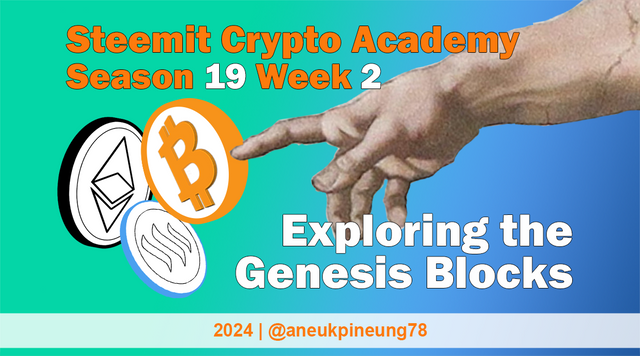
Note : I performed this task on Windows 10 PC, Google Chrome.
Task 1 - Explain the importance of the Bitcoin genesis block and describe its contents. Discuss the message hidden in the genesis block and its impact on the birth of Bitcoin.
The Importance of Bitcoin Genesis Block
There can be no doubt that the beginning of every block in the blockchain world is the Bitcoin Genesis Block. This block not only serves as the foundation for Bitcoin blockchain but also pioneers the evolving world of blockchain, which now has acquired numerous characteristics.
The first block in the Bitcoin blockchain world (known as 'Block 0') has been the 'mother' to all blocks in blockchain technology. It is not only the most significant block marking the most revolutionary step in Bitcoin's history. When someone (or a group of people) who called themselves Satoshi Nakamoto initiated the very first transaction in the blockchain world (which was first broadcasted on the Bitcoin network on January 4, 2009, at 1:15:05 UTC+7), they not only ushered in the birth of Bitcoin but also the entire blockchain technology that followed.
One very interesting fact is that Satoshi launched Bitcoin (with its first transaction that birthed the Genesis Block) in 2009, amidst the global economic crisis. There is an interesting fact behind why Satoshi chose the date of January 3rd (4th UTC+7) to launch the Bitcoin's very first block, we'll dive in to it.
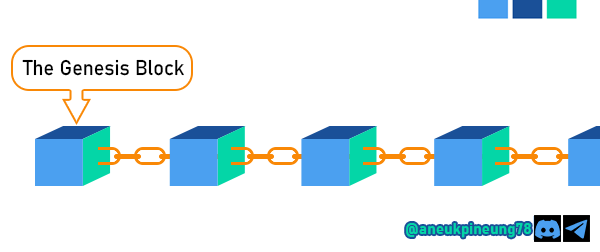
The Contents of the Bitcoin Genesis Block
Each block in a blockchain has layers containing different information. This layered system is intended to prevent the system from being centralized around a single entity, which is why blockchain networks are called decentralized networks. There are 5 layers in blockchain technology, from the core to the outermost, they are: 1) Hardware / Infrastructure Layer; 2) Data Layer; 3) Network Layer; 4) Consensus Layer; and 5) Application and Presentation Layer.
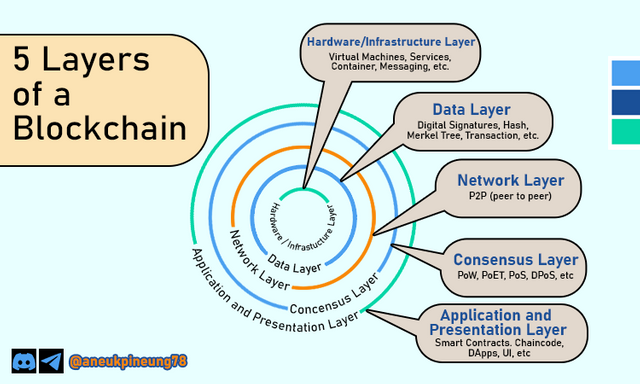
All the information we need to know about a block are stored in the Data layer, which contain data including:
- Transaction,
- Header (the identity of a block),
- Previous block address (the Genesis Block as the first block does not contain the previous block address),
- Timestamp,
- Nonce,
- Merkle Root.
In addition to storing this data, this layer also works to verify transactions by requiring a digital signature for each transaction. Some of the data that can be obtained from this layer are the identity of the block miner, the number of transactions made, the rewards minted, input and output values, and so on.
To view the data contained within the Bitcoin Genesis Block, I use the block explorer from blockchain.com. The link to the Bitcoin Genesis Block on the blockchain explorer of blockchain.com is https://www.blockchain.com/explorer/blocks/btc/0. Below is the screenshot of the Bitcoin Genesis Block (Block 0) data as seen on blockchain.com.
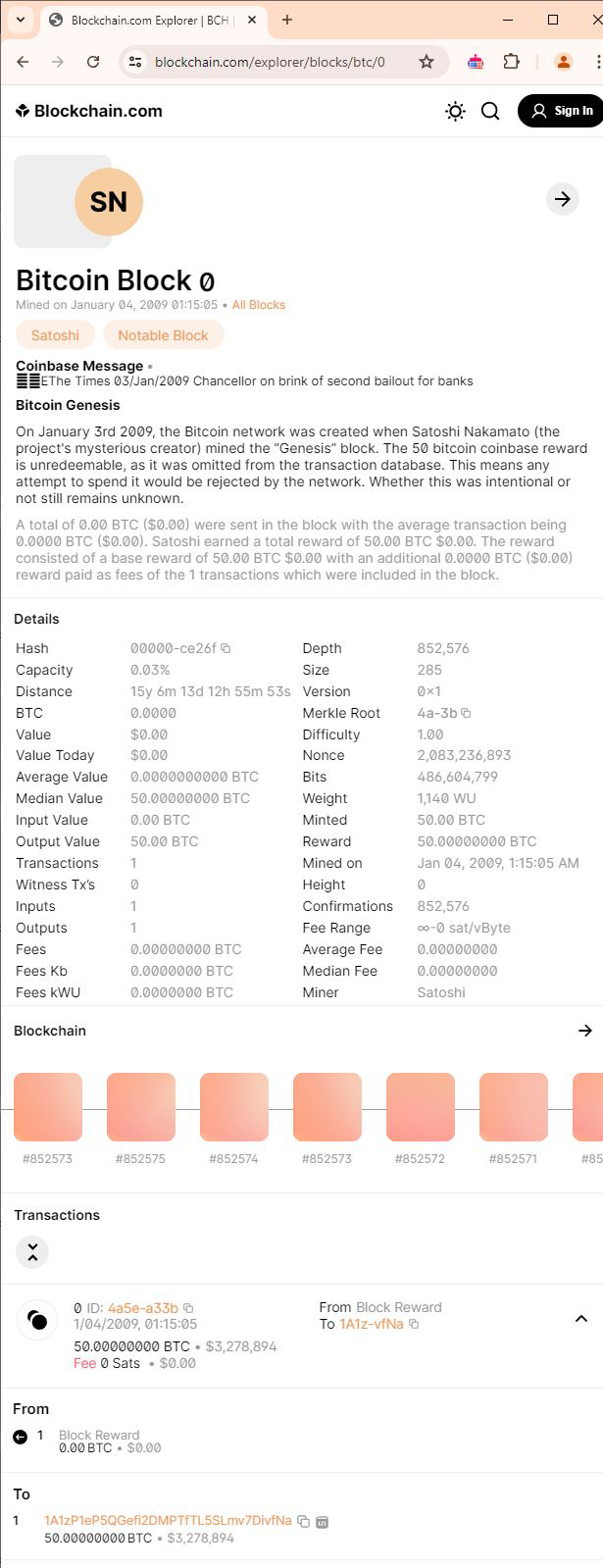
Some information can be highlighted from the page:
- This transaction was first broadcasted on the Bitcoin network at 1:15:05 AM on January 4, 2009 (GMT+7).
- The block had a value of $0.00 when mined and currently holds the same value.
- The block contains 1 transaction, with an input value of 0.00 BTC and an output value of 50.00 BTC (equivalent to $3,278,958).
- There was no fee charged for this transaction.
- The block was mined by someone named 'Satoshi'.
- This block rewarded 50.00 BTC to 1A1zP1eP5QGefi2DMPTfTL5SLmv7DivfNa, which is the Bitcoin address of Satoshi Nakamoto’s. (When I tried to take a glimpse at the wallet, it showed that it has 100.10125378 BTC which is equal to $6,519,873. That’s huge! Throughout history, this address has only sent a very small amount of BTC, only equal to USD 2.19. And at the moment I wrote this article, it has done 30,022 transactions with the latest transaction was done at 14:05:56 on July 17, 2024.)
The interesting fact about the very first block in the blockchain world is that it generated a reward of 50 BTC which is unspendable, 'as it was omitted from the transaction database,' writes blockchain.com. It remains a mystery whether this was intentional or merely a mistake made by Satoshi.
The Message Hidden In The Genesis Block of Bitcoin
The Bitcoin Genesis Block, which contained only one transaction performed by an entity calling themselves Satoshi. They left a hidden message. Actually, it's no longer hidden, as the message stored in the block's raw data has become a topic of widespread discussion in the blockchain world. It's referred to as "hidden" perhaps because the message is like a puzzle, with the hidden meaning.
The message embedded by Satoshi in the block's raw data reads, "The Times 03/Jan/2009 Chancellor on brink of second bailout for banks." On the day Satoshi made this transaction, January 3, 2009, The Times front page report was titled "Chancellor On Brink Of Second Bailout For Banks."
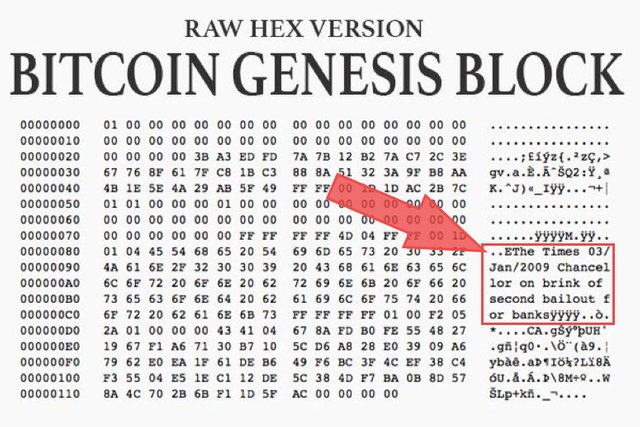

Source: Decoding Bitcoin’s First Block Coinbase Transaction.
This message has increased people's curiosity because Satoshi never commented on it afterward, or at least his comments never reached the public. However, nevertheless, the message can be easily interpreted as the goal of Bitcoin itself, namely to create a new economic order, digitally, based on decentralized cryptography technology. The original print of The Times newspaper edition of January 3, 2009 is also reportedly one of the most sought-after newspaper editions today, like Bitcoin itself.
Opinions like these gain more strength when connected with the message left by Satoshi Nakamoto on February 11, 2009, on the message board for the P2P Foundation. There's a circulating belief that Satoshi Nakamoto is an entity (whether an individual or a group) that holds disdain for the traditional financial system. Their message on the P2P Foundation message board further reinforces this belief. They opened this message by directly attacking the traditional economic system in the first paragraph,
“The root problem with conventional currency is all the trust that's required to make it work. The central bank must be trusted not to debase the currency, but the history of fiat currencies is full of breaches of that trust. Banks must be trusted to hold our money and transfer it electronically, but they lend it out in waves of credit bubbles with barely a fraction in reserve. We have to trust them with our privacy, trust them not to let identity thieves drain our accounts. Their massive overhead costs make micropayments impossible.”
The complete version of Satoshi’s message which was entitled ”Bitcoin open source implementation of P2P currency” can be read here.
The fact that the 50 BTC successfully mined from Block 0 (Bitcoin Genesis Block) cannot be spent can indeed be seen as a unique anomaly within the plan to introduce a new economic order. This has also become an interesting fact in Bitcoin's history, especially in its early days.
Impact of the Hidden Message Have On the Birth of Bitcoin
At that time, in January 2009, the world was experiencing an economic crisis. The front-page headline of The Times' January 3, 2009 edition, which Satoshi referenced in the raw data of the first transaction, explicitly referred to the fragility of the centralized economic system. It was as if, when Satoshi initiated the first transaction, he was saying that it was time for a new economic system where everyone could control their own money without intermediaries profiting unreasonably.
That might be why Satoshi chose January 3 (January 4 GMT+7) to make the first transaction and gave birth to Bitcoin.

Task 2 - Compare and contrast Ethereum's genesis block with Bitcoin's. What are the specific elements of the Ethereum genesis block, such as pre-funded accounts and smart contracts?
The Comparison and Contrast of Ethereum's Genesis Block With Bitcoin's
Let's delve into the Ethereum Genesis Block before we make a comparison. I am using the Ethereum blockchain explorer from oklink.com, which has the address of the Ethereum Genesis Block at https://www.oklink.com/eth/block/0.
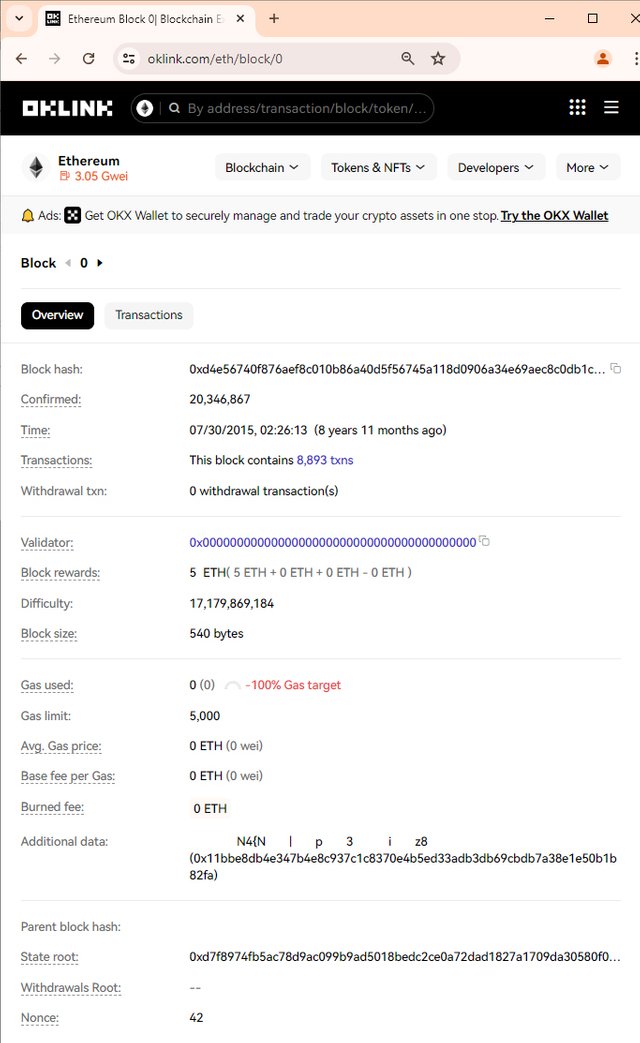
Now let's take a closer look at some interesting facts about the birth of these two blockchains.
It is interesting to note the different facts in the birth of the two blockchains. If the first block of the Bitcoin blockchain contained only one transaction that generated a reward of 50 BTC, making it the first 50 BTC in its history, it is different from the first block of Ethereum, which contained 8,893 transactions aimed at distributing 60,102,216 ETH (Ether, the coins of the Ethereum blockchain) to early adopters. This amount was sold for 31,591 BTC, equivalent to USD 18.4 million at the average exchange rate on the last day of the ICO (September 2, 2014). The 42 days ICO offers 72 million Ethers, the initial supply, and sold about 80% of the total offered.
Another interesting thing is that, if the Bitcoin Genesis Block was triggered by a single transaction conducted by Satoshi, making its launch a centralized one. The launch of the Ethereum mainnet was different. Frontier (Ethereum's initial mainnet) was launched by consensus among the participating early adopters. However, compared to most blockchains that emerged later, the Ethereum launch pattern is still considered relatively more centralized.
Now, putting the data from each Genesis Block and the interesting facts surrounding the birth of the 2 blockchains into a table using Microsoft Excel, to make it easier to compare.
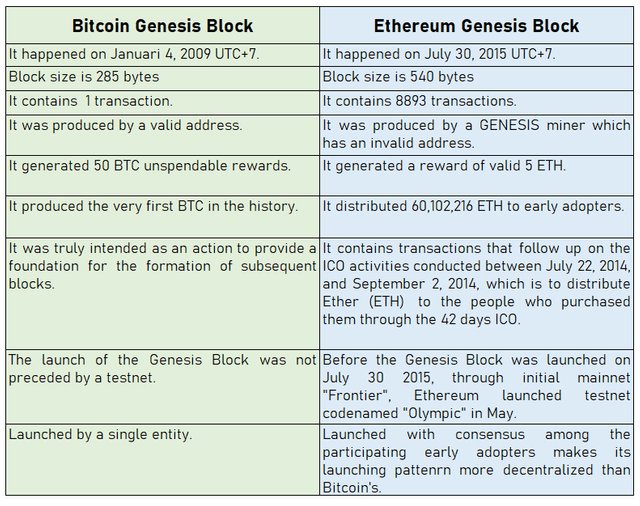
The Specific Elements of Ethereum Genesis Block (Pre-Funded Accounts and Smart Contracts)
Amongst the specific elements of Ethereum Genesis Block are Pre-funded Accounts, Smart Contracts, invalid address.
Pre-funded Accounts
Prefunded Accounts are Ethereum accounts (or addresses) that have been funded when they were created. Ethereum Genesis Block hold record of more than 8,000 accounts which were immediately funded with the amount of Ether (ETH) they had purchased during the 42-day ICO. The exact number of this prefunded account is 8,893. The biggest number of Ether was sent to 0x5abfec25f74cd88437631a7731906932776356f9 which was 11,901,484.23948 ETH. I found this information from Ethereum Block Explorer of oklink.com. Unlike Etherscan Ethereum Block Explorer, oklink has the transaction amount filtering feature.
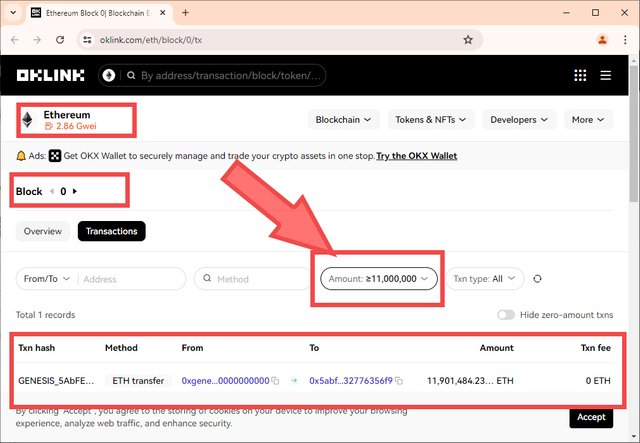
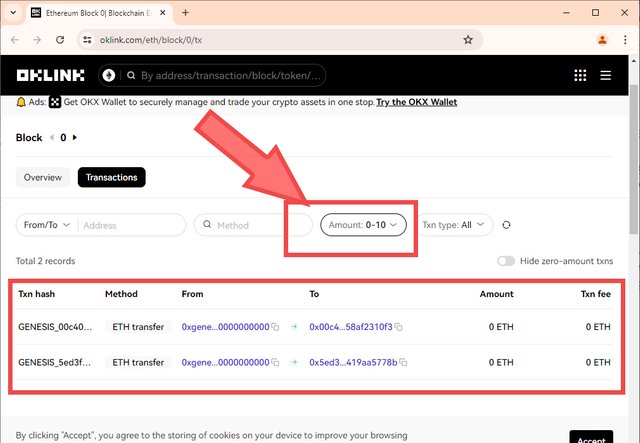
Smart Contracts
Smart Contracts, also known as Contracts or Contract Accounts, do not have a private key but contain codes that execute when receiving a transaction from an External Account. These self-executing computer programs (codes) act so to enforce automatically enforce the term of an agreement to parties.
The broader possibilities offered by Smart Contracts, which were conceived by the founder Vitalik Buterin, allow developers to create broad array of applications. It is safe to say that aligns with the birth of the Ethereum blockchain, the term DApps (Decentralized Applications) was born, whose potential uses and benefits are also very extensive. Among them are offering greater support to DeFi (Decentralized Finance), supply chain management, and more.
Smart contracts also paved the way for the emergence of NFTs (Non-Fungible Tokens), which serve as proof of ownership of a digital asset (which can be in the form of images, videos, or audio). With this technology, an artist can tokenize their works, giving those digital works digital identities recorded on the blockchain, and then trade it digitally.
Smart Contracts are what have come and become an incredibly significant breakthrough in the blockchain world since the birth of the blockchain itself. For this reason, Ethereum is also referred to as the Second Generation Blockchain.
It all is made possible with the use of the native Solidity scripting language and the Ethereum Virtual Machine
Invalid Address
8,893 transactions that occurred in the Ethereum Genesis Block were carried out by an invalid account with the address GENESIS or 0xgenesis000000000000000000000000000000000. Although 8,893 transactions were conducted in the Genesis Block, the OKLink Ethereum Blockchain Explorer records no data stored related to this address, as seen here. Below is the screenshot from the web page.
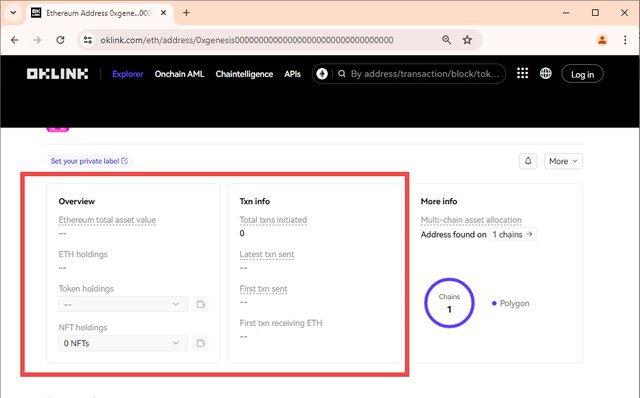

Task 3 - Use a blockchain explorer to find details about Steem's genesis block. What are the main components and transactions in this block? Provide screenshots and links to the browser used.
Unlike Bitcoin and Ethereum, which refer to their first block as Block 0, Steem names its genesis block as Block 1.
To explore the Steem Blockchain, you can use the Steem Block Viewer created by @justyy, accessible at steemy.com, or use the Steem Block Explorer feature at SteemWorld. SteemWorld is the work of @steemchiller. I will use both and compare the data.
In this task I use both. The first one is justyy’s Steem Block Viewer. The web address for the Steem Genesis Block is https://steemyy.com/block.php?b=1..
Below is the screenshot.
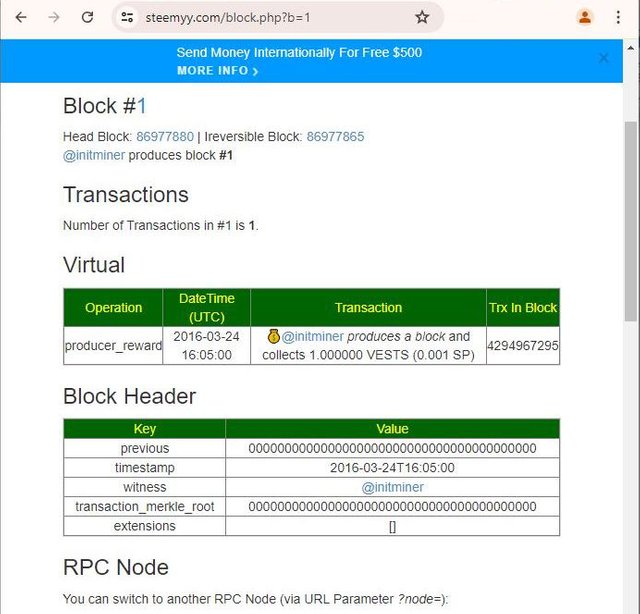
Below is the screenshot from SteemWorld Steem Block Explorer. The address for the Genesis Block is https://steemworld.org/block/1.
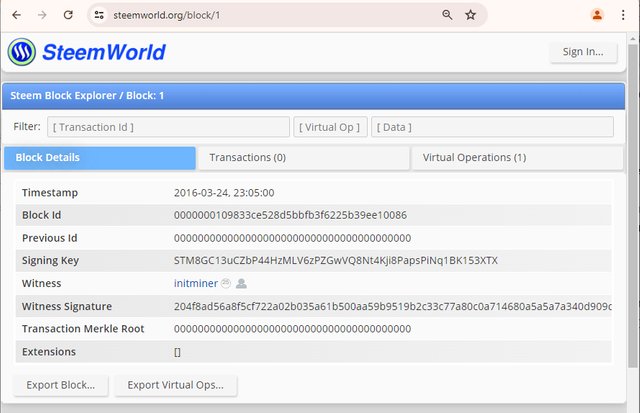
The both Steem Block Explorers for the Steem Genesis Block shows information such as:
- The block contains only one virtual transaction which was producer_reward;
- The block was initiated by @initminer;
- The virtual transaction was made on March 24th 2016, at 16:05:00 UTC.
- On that transaction, @initminer produced a block and collected 1.000000 VESTS (0.001 SP);
- previous (previous block hash) is 0000000000000000000000000000000000000000 which mean it has no previous block, but it has to contain data so the data contains a string of zero;
- the witness for the block is also @initminer
Steemworld’s Steem Explorer contains information about Block Id while stemyy does not.

Task 4 - Compare the genesis blocks of Bitcoin, Ethereum and Steem in terms of goals, underlying technologies and communities.
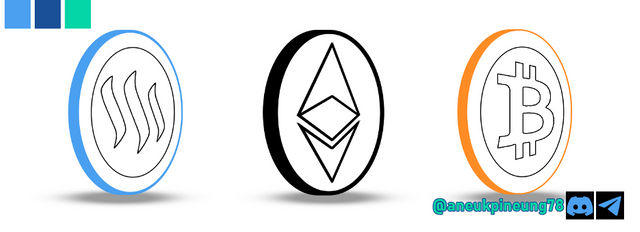
Bitcoin
The Bitcoin Genesis Block laid the foundation for a peer-to-peer digital cash transaction system that eliminates intermediary involvement and centralization, which in traditional economic systems is controlled by banks. This leads to the Bitcoin community being more focused solely on financial activities: sending and receiving Bitcoin. Within this community, Bitcoin can be treated both as a payment tool and as a stock.
Ethereum
The Ethereum Genesis Block brought about remarkable changes compared to first-generation blockchain technology, making Ethereum known as the second generation. Ethereum expanded its scope to become a blockchain capable of accommodating developers to create blockchain-based applications, and it can also be used to provide digital identities for someone's digital works so they can be traded digitally. Additionally, as demonstrated by ICO activities, Ethereum also declared itself as a blockchain that can accommodate fundraising.
The broad opportunities enabled by Smart Contracts make the Ethereum community vibrant and innovative in bringing various decentralized applications to life. This community's activities extend beyond economic activities (sending and receiving money, staking) carried out across various applications, to also include the creativity of creators in producing and marketing their digital works.
Steem
The Steem Genesis Block was created with the goal of establishing a decentralized blockchain, similar to the original purpose of the Bitcoin blockchain, but at the same time building a strong community across the world, creating opportunities to reward creators, empowering entrepreneurs, and facilitating digital and decentralized fundraising.
Therefore, in addition to the decentralized economic aspects as the fundamental mandate of blockchain technology, Steem users also form a borderless community that can organize itself for activities such as fundraising, education, and more. This is achieved through the blogging technology of Steemit, which utilizes Markdown language.

Task 5 - Practical Question: Creating a Genesis Block Guide | Write a practical guide explaining how a newcomer can explore and understand the genesis block of a blockchain, using examples from Bitcoin, Ethereum and Steem.
To explore blocks in a blockchain, a blockchain explorer is needed. Every blockchain can have more than one blockchain explorer. For example, Steem has at least 2: Steem Block Viewer from steemy.com and Steem Block Explorer from steemworld.org. It is recommended to use more than one blockchain explorer to get more comprehensive information, as each blockchain explorer, while presenting the same data, has different presentation characteristics. For instance, the Ethereum blockchain explorer by Etherscan does not provide a filter feature, so when we find a block containing a lot of transaction data, it is difficult to find information about the largest transaction value among all of them. This issue is resolved by the filtering feature of the Ethereum block explorer on oklink.com, as I demonstrated above.
Additionally, it should be noted that not all blockchains name their first block 'Block 0' as Bitcoin and Ethereum do. Steem names its first block 'Block 1'.
Below is the list containing links to the explorers of 5 well-known blockchains.
| No. | Blockhain | Explorers |
|---|---|---|
| 1 | Bitcoin (BTC) | bitapss.com; btc.com; blocksteam.info; blockchain.com |
| 2 | Ethereum (ETH) | etherscan.io; ethplorer.io blockscout.com; oklink.com; |
| 3 | Steem (STEEM, SBD) | steemyy.com; steemworld.org; |
| 4 | TRON (TRX) | tronscan.org; oklink.com; tokenview.io |
| 5 | Monero (XMR) | localmonero.co; xmrscan.org/ |
In this case, I will demonstrate the use of the Steem Block Explorer from SteemWorld, which can be accessed at https://steemworld.org/.
'1. Go to https://steemworld.org/ and click on Block Explorer.
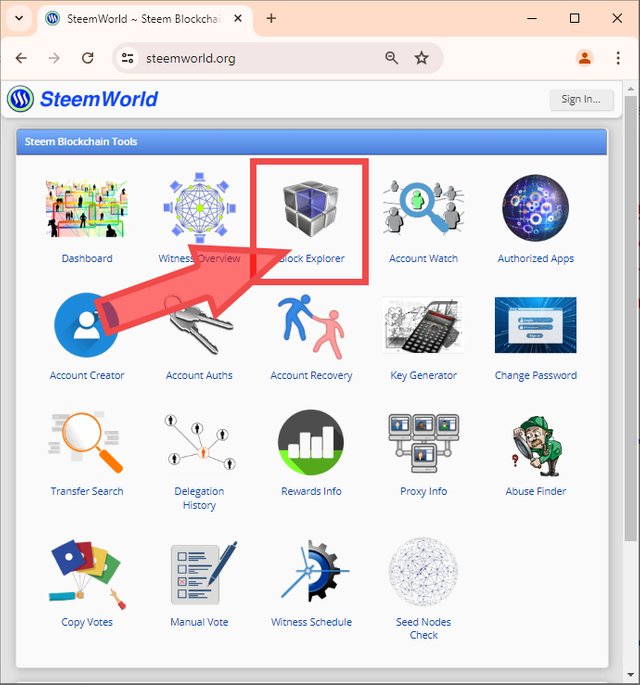
'2. Enter the block number you want to explore. Remember, the Steem Genesis Block is named Block 1, so if you want to view the Genesis Block data, enter the number 1. I am still curious why the default number there is 61000000.
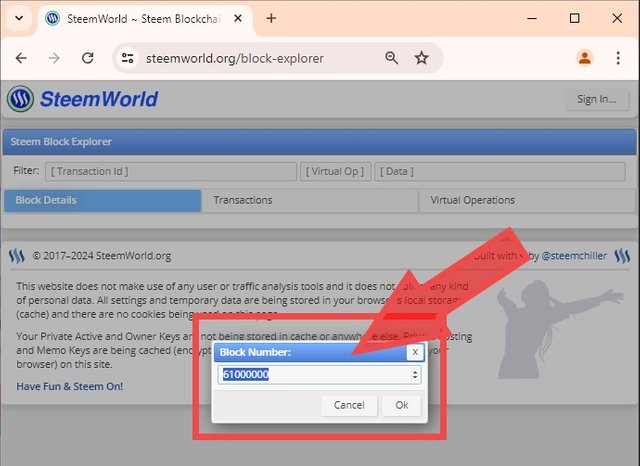
'3. Next, a page will appear showing the data of the block in question, in this case, the Genesis Block or Block 1.
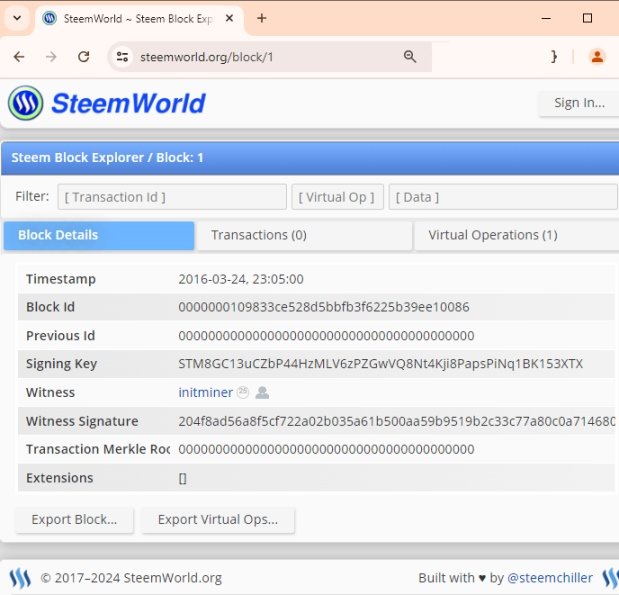
It's so easy, right? The procedure is the same for all blockchain explorers. In many cases, the blockchain explorer is integrated into a website and serves as a feature. In such cases, users can utilize the provided search feature by entering the block number they want to view the data for. It's that simple. And, some websites provides more than 1 blockchain explorers, they could have explorers for various blockchains.

Thanks
Thanks @crypto-academy for the lesson.
Pictures Sourcing
- The editorial picture was created by me’. It features the hand from Michelangelo’s painting The Creation of Adam as seen on https://en.wikipedia.org/wiki/The_Creation_of_Adam.
- Unless otherwise stated, all another pictures were screenshoots and were edited with Photoshop 2021.
Sources and Reading Suggestion
- https://en.bitcoin.it/wiki/Genesis_block
- https://www.blockchain.com/explorer/blocks/btc/0
- https://aws.amazon.com/id/what-is/blockchain/
- https://www.geeksforgeeks.org/blockchain-structure/
- https://www.investopedia.com/terms/b/block-header-cryptocurrency.asp
- https://bitcoin.com.au/when-was-bitcoin-created-exploring-the-origins-of-cryptocurrency/
- https://www.bitpanda.com/academy/en/lessons/the-bitcoin-whitepaper-simply-explained/
- https://www.geeksforgeeks.org/genesis-block-in-blockchain/
- https://pintu.co.id/academy/post/mengenal-layer-blockchain
-https://www.investopedia.com/terms/g/genesis-block.asp - https://cryptobriefing.com/bitcoin-birthday-satoshi-hidden-message-explained/
- https://p2pfoundation.ning.com/forum/topics/bitcoin-open-source?id=2003008%3ATopic%3A9402&page=1
- https://www.investopedia.com/terms/b/block-header-cryptocurrency.asp
- https://learnmeabitcoin.com/technical/block/hash/
- https://medium.com/@mantri-nodes/exploring-ethereums-genesis-block-2d28fd282fb8
- https://cointelegraph.com/explained/what-is-the-genesis-block-explained
- https://medium.com/@beyond_verse/ethereum-genesis-block-from-vision-to-reality-the-journey-of-vitalik-buterin-fb03a52afd23
- https://news.bitcoin.com/14th-anniversary-of-bitcoins-genesis-block-a-look-back-at-the-birth-of-cryptocurrency/
- https://medium.com/geekculture/decoding-bitcoins-first-block-coinbase-transaction-aeefe87ceec0
- https://en.bitcoin.it/wiki/Genesis_block
- https://ethereum.org/en/developers/docs/smart-contracts/
- https://ethereum.stackexchange.com/questions/40665/create-prefunded-accounts-on-a-test-blockchain
- https://medium.com/@alexberegszaszi/pre-funded-ethereum-contracts-3873adf67e36
- https://aws.amazon.com/blockchain/what-is-ethereum/
- https://www.pwc.com/us/en/industries/financial-services/fintech/bitcoin-blockchain-cryptocurrency.html
- https://steem.com/about/




cryptoacademy-s19w2 indonesia steemexclusive club75 blockchain

Saya mengajak teman-teman berikut untuk menulis di Crypto Academy: @rayfa, Pak Guru @bahrol, Pak Guru @fadthalib, Bang @lord-geraldi.
Waduhhh, ini tulisan berat, hanya para "suhu krypto" yang mampu menjelaskan seperti yang anda presentasikan. Saya pikir dengan lampiran link berita yang demikian banyak, sudah sangat sesuai dengan komunitas akademi kripto. Jika ini menjadi model baru penulisan di steemit maka akan menaikan derajat kepercayaan terhadap para penulis di steemit.
Terimakasih Pak Guru Fadthalib.
Saya sebenarnya menikmati menyelesaikan tugas-tugas di Steemit Crypto Academy. Percaya tidak? Tulisan ini saya persiapkan selama berhari-hari. Membaca artikel-artikel, menarik kesimpulan sementara di dalam kepala, menuangkan kesimpulan ke dalam tulisan, mengkoreksi dengan melakukan cross-check ke sumber-sumber lain, pokoknya sangat mengasyikkan.
Terlepas dari itu adalah saya mungkin menjadi lebih pintar dari minggu sebelumnya, atau malah justru lebih bodoh, sebab seperti mereka bilang, "Makin tahu sesuatu, makin kita tahu bahwa kita sebenarnya makin tidak tahu." Hahaha, saya jadi teringat saudara kita @wakeupkitty.
Oh iya Pak Guru, bagaimana sudah perkembangan presentasi Pak Guru. Saya benar-benar ingin membaca apa yang Pak Guru sampaikan. Hal itu telah lama menjadi salah satu ketertarikan saya. Saya benar-beanar menunggu.
Sesuatu yang kita kerjakan jika itu membuat senang, mengapa tidak?. Ada kepuasan tersendiri ketika berhasil merangkum semua sumber sehingga menghasilkan satu kesimpulan menurut pandangan penulis. Terlepas dari hasilnya juga terkadang membingungkan kita sendiri, wkwkwk.
Saya sudah mempresentasikan kepada siswa terkait rupiah sebagai simbol kedaulatan bangsa. Malam ini saya mulai membuat pengantar awal dulu, nanti kalo sudah selesai saya mention jenengan.
Nah terkait kebingungan itu, ada seorang teman yang sudah kelewat bijak pernah berkata, "Kamu belum mengerti kalau belum bingung." Hahaha. Apa orang harus linglung semua seperti Albert Einstein agar dunia ini semakin berkilau dengan sinar pengetahuan. 😅😅
Ah. Iya. Itu adalah janji yang saya menanti kapan akan tiba. Terimakasih sebelumnya, Pak Guru.
This writing is like really learning, there is something I understand and there is also a lot I don't understand.
I think I'll read it first and study it, maybe later I'll take part.
Nice job mate 😁👍
A lot of article had to be read in preparation of this homework post, see the list on bottom part. Haha. I guess you should take part sometimes.
Sungguh hebat anda ini, bisa merangkan penjelasan yang begitu terperinci, serta penuh denga serat ilmu, anda memang orang yang sangat luar biasa, kaya akan pemahamannya.
Saya takjub kepada penulisan anda yang sangat hebat dalam merangkan rangkuman yang komplit.
Terimakasih Pak Guru Bahrol.
Saya hanya mencoba menuliskan apa yang dijadikan sebagai tugas oleh pengajar di Crypto Academy. Selanjutnya saya akan menunggu penilaian yang akan diberikan untuk mengetahui di mana kelemahan saya.
Semoga tulisan ini dianggap mampu memenuhi apa yang diharapkan.
Tugas-tugas di Steemit Crypto Academy akan membuat kita semakin mengenali seluk beluk dunia blockchain. Jadi walaupun nilai yang saya dapat rendah tapi tetap berguna bagi pemahaman saya terkait blockchain.
Setelah menyelesaikan beberapa tugas di Crypto Academy, saya semakin paham demikian luasnya dunia blockchain dan karenanya saya jadi ingin terus menulis di sini. Ini merangsang saya untuk mau membaca dan mengeluarkan kreatifitas saya dalam menjabarkan kesimpulan dari apa saja yang telah saya baca ke dalam sebuah tulisan dengan mematuhi batasan yang ditetapkan.
Ini menurut saya adalah sesuai dengan nilai dasar Steemit yang sejak awal ingin menumbuhkan sebuah komunitas lintas batas yang "kuat".
Terima kasih @aneukpineung78 , memang terpikir untuk kembali menulis
Iya, ditunggu...
The explanation is very good and neatly organized. I am amazed at your knowledge of Genesis blocks. For me, this can add insight in understanding blockchain.
Thank you, Chairman, for your comment.
I am actually grateful for the existence of Crypto Academy, which, through the given assignments, makes me read a lot. Thus, my curiosity about the blockchain world, which had already existed, found a more directed path for information seeking. This is because the assignments are systematically designed, guiding those who complete them to find an easier path to understandings, and to some extent, quenching their thirst for knowledge of the matter.
I like your writing because you explain it in very simple language so it is easy to understand.
Very nice information you shared especially the links for the explorer's, that will be very helpfull.
The search engines made it all possible. 😁 Thanks, stream4u.
Greetings
You have shared very detailed information about the block Genesis their origin and hidden message inside it in a precise ways you made it very clear to understanding the topic for us.
In a details way you gave a clear picture of etherum and Bitcoin their comaparion and difference are well structures and easy to know.
Good luck
Okay, I see you have done some great work as well. Congrats!
WOW 😨😳, you blew my mind, I didn't see this coming. You gave a deeper explanation and I would say you did perfectly friend please keep it up 👍🏼.
I really enjoyed your content, indeed such post nourishes our beloved platform, all your definition are perfect bro. Thanks for sharing, please engage on my entry through the link below 👇🏼https://steemit.com/hive-108451/@starrchris/eng-esp-steemit-crypto-academy-contest-s19w2-exploring-the-genesis-blocks-or
Didn't mean to blow anyone's mind (sorry now that you had to collect yours on the floor). Haha. I just tried to do this the best I can.
Well, the more importantly then whether this is well received or not is: does it add value to the readers?
Thanks.
Great job on exploring the genesis blocks of Bitcoin, Ethereum, and Steem! Your detailed analysis on their components and the hidden messages in Bitcoin's genesis block was especially insightful.
The search engines made it all possible, Artist1111.